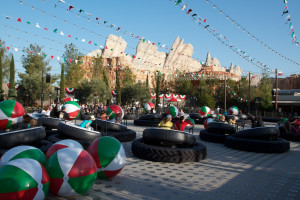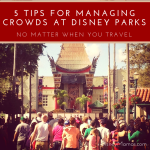The first time I remember seeing a hovercraft was while watching Star Wars in 1977 – I was six years old. At the time it seemed quite possible that “a long time ago” would hit around the year 2000 and we’d all be driving in hovercars. By the time I was a teen the commute of George Jetson seemed a little far fetched, but, I really believed Marty’s hoverboard could be a reality. Alas, hoverboards should be out next year, and that looks highly unlikely. Besides, at this point I’m not quite as brave as I once was and know that hopping on a hoverboard should be something left to the young and reckless.
No need for despair, because at Disney’s California Adventure, you can ride a hover craft right now. The concept started in 1961 when the Flying Saucers opened in Disneyland’s Tomorrowland. The attraction was something between bumper cars and air hockey. Imagineer Roger Broggie describes stage the design process like this:
“We had figured that we could move a two-thousand pound payload if we had an air jet below with valves that allow air to come up through holes in the floor. It just so happened that a bunch of surplus actuators from the second stage of a Jupiter missile came onto the market. We bought them and put them to use. When the actuators were installed, they almost immediately failed and Disney sent them back. They wanted to know what we had done to make them wear out like this. We estimated the actuators had cycled more than seven million times. They said that their test program had required that the actuators were actually used for five seconds on the second stage of the Jupiter missile for pitch control, then their purpose was fulfilled. They said that we’d over designed it by seven times!”
The solution was to use four giant blowers mounted below the ground to maintain the air pressure in a 16,000 square foot network of air ducts with holes and valves. As a flying saucer passed over a valve, the air pressure would become imbalanced and the valve would open which provided the lift. The constant air pressure would quickly close the valve once the saucer moved on. To steer, guests would lean in any direction and the saucer would respond to the shift. However, if the weight was centered, the saucer would begin to “hop” up and down requiring the guest to lean again. Unfortunately, the pressure under the floor would drop so low at times, that all the valves would open at once, releasing the air beneath, causing a window rattling sonic boom and all the saucers would drop to the ground. Sadly, due to low capacity, the quantity of cast members needed to run the attraction, and design flaws, the saucers closed in 1966.
But thanks to computer technology, guests can once again ride upon a cushion of air. This time, in a giant white-wall. The basic elements of the attraction are the same, it is more reliable, and full of nostalgic fun – including the long wait time to ride.

















